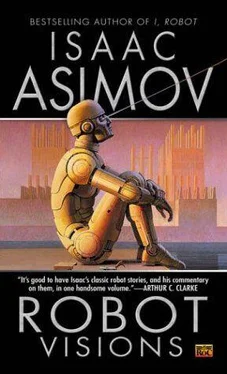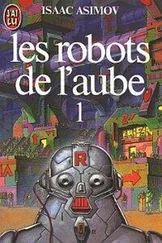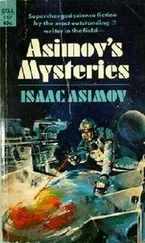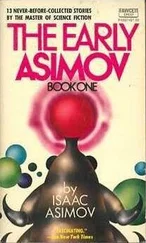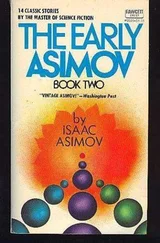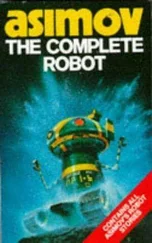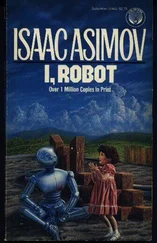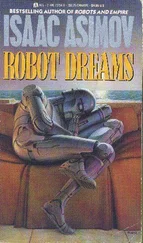Isaac Asimov - Robot Visions
Здесь есть возможность читать онлайн «Isaac Asimov - Robot Visions» весь текст электронной книги совершенно бесплатно (целиком полную версию без сокращений). В некоторых случаях можно слушать аудио, скачать через торрент в формате fb2 и присутствует краткое содержание. Жанр: Фантастика и фэнтези, на английском языке. Описание произведения, (предисловие) а так же отзывы посетителей доступны на портале библиотеки ЛибКат.
- Название:Robot Visions
- Автор:
- Жанр:
- Год:неизвестен
- ISBN:нет данных
- Рейтинг книги:5 / 5. Голосов: 1
-
Избранное:Добавить в избранное
- Отзывы:
-
Ваша оценка:
- 100
- 1
- 2
- 3
- 4
- 5
Robot Visions: краткое содержание, описание и аннотация
Предлагаем к чтению аннотацию, описание, краткое содержание или предисловие (зависит от того, что написал сам автор книги «Robot Visions»). Если вы не нашли необходимую информацию о книге — напишите в комментариях, мы постараемся отыскать её.
Robot Visions — читать онлайн бесплатно полную книгу (весь текст) целиком
Ниже представлен текст книги, разбитый по страницам. Система сохранения места последней прочитанной страницы, позволяет с удобством читать онлайн бесплатно книгу «Robot Visions», без необходимости каждый раз заново искать на чём Вы остановились. Поставьте закладку, и сможете в любой момент перейти на страницу, на которой закончили чтение.
Интервал:
Закладка:
Thus, in the very first printed version of “Robbie,” I had a character refer to a robot as follows: “He just can’t help being faithful and loving and kind. He’s a machine, made so.”
After writing “Robbie,” which John Campbell, of Astounding Science Fiction, rejected, I went on to other robot stories which Campbell accepted. On December 23, 1940, I came to him with an idea for a mind-reading robot (which later became “Liar!”) and John was dissatisfied with my explanations of why the robot behaved as it did. He wanted the safeguard specified precisely so that we could understand the robot. Together, then, we worked out what came to be known as the “Three Laws of Robotics. “ The concept was mine, for it was obtained out of the stories I had already written, but the actual wording (if I remember correctly) was beaten out then and there by the two of us.
The Three Laws were logical and made sense. To begin with, there was the question of safety, which had been foremost in my mind when I began to write stories about my robots. What’s more I was aware of the fact that even without actively attempting to do harm, one could quietly, by doing nothing, allow harm to come. What was in my mind was Arthur Hugh Clough’s cynical “The Latest Decalog,” in which the Ten Commandments ate rewritten in deeply satirical Machiavellian fashion. The one item most frequently quoted is: “Thou shalt not kill, but needst not strive / Officiously to keep alive.”
For that reason I insisted that the First Law (safety) had to be in two parts and it came out this way:
1. A robot may not injure a human being, or, through inaction, allow a human being to come to harm.
Having got that out of the way, we had to pass on to the second law (service). Naturally, in giving the robot the built-in necessity to follow orders, you couldn’t forfeit the overall concern of safety. The Second Law had to read as follows, then:
2. A robot must obey the orders given it by human beings except where such orders would conflict with the First Law.
And finally, we had to have a third law (prudence). A robot was bound to be an expensive machine and it must not needlessly be damaged or destroyed. Naturally, this must not be used as a way of compromising either safety or service. The Third Law, therefore, had to read as follows:
3. A robot must protect its own existence, as long as such protection does not conflict with the First or Second Laws.
Of course, these laws are expressed in words, which is an imperfection. In the positronic brain, they are competing positronic potentials that are best expressed in terms of advanced mathematics (which is well beyond my ken, I assure you). However, even so, there are clear ambiguities. What constitutes “harm” to a human being? Must a robot obey orders given it by a child, by a madman, by a malevolent human being? Must a robot give up its own expensive and useful existence to prevent a trivial harm to an unimportant human being? What is trivial and what is unimportant?
These ambiguities are not shortcomings as far as a writer is concerned. If the Three Laws were perfect and unambiguous there would be no room for stories. It is in the nooks and crannies of the ambiguities that all one’s plots can lodge, and which provide a foundation, if you’ll excuse the pun, for Robot City.
I did not specifically state the Three Laws in words in “Liar!” which appeared in the May 1941 Astounding. I did do so, however, in my next robot story, “Runaround,” which appeared in the March 1942 Astounding. In that issue on line seven of page one hundred, I have a character say, “Now, look, let’s start with the three fundamental Rules of Robotics,” and I then quote them. That incidentally, as far as I or anyone else has been able to tell, represents the first appearance in print of the word “robotics”-which, apparently, I invented.
Since then, I have never had occasion, over a period of over forty years during which I wrote many stories and novels dealing with robots, to be forced to modify the Three Laws. However, as time passed, and as my robots advanced in complexity and versatility, I did feel that they would have to reach for something still higher. Thus, in Robots and Empire, a novel published by Doubleday in 1985, I talked about the possibility that a sufficiently advanced robot might feel it necessary to consider the prevention of harm to humanity generally as taking precedence over the prevention of harm to an individual. This I called the “Zeroth Law of Robotics,” but I’m still working on that.
My invention of the Three Laws of Robotics is probably my most important contribution to science fiction. They are widely quoted outside the field, and no history of robotics could possibly be complete without mention of the Three Laws. In 1985, John Wiley and Sons published a huge tome, Handbook of Industrial Robotics, edited by Shimon Y. Nof, and, at the editor’s request, I wrote an introduction concerning the Three Laws.
Now it is understood that science fiction writers generally have created a pool of ideas that form a common stock into which all writers can dip. For that reason, I have never objected to other writers who have used robots that obey the Three Laws. I have, rather, been flattered and, honestly, modem science fictional robots can scarcely appear without those Laws.
However, I have firmly resisted the actual quotation of the Three Laws by any other writer. Take the Laws for granted, is my attitude in this matter, but don’t recite them. The concepts are everyone’s but the words are mine.
The Laws Of Humanics
My first three robot novels were, essentially, murder mysteries, with Elijah Baley as the detective. Of these first three, the second novel, The Naked Sun, was a locked-room mystery, in the sense that the murdered person was found with no weapon on the site and yet no weapon could have been removed either.
I managed to produce a satisfactory solution but I did not do that sort of thing again.
The fourth robot novel, Robots and Empire, was not primarily a murder mystery. Elijah Baley had died a natural death at a good, old age, the book veered toward the Foundation universe so that it was clear that both my notable series, the Robot series and the Foundation series, were going to be fused into a broader whole. (No, I didn’t do this for some arbitrary reason. The necessities arising out of writing sequels in the 1980s to tales originally written in the 19408 and 1950s forced my hand.)
In Robots and Empire, my robot character, Giskard, of whom I was very fond, began to concern himself with “the Laws of Humanics,” which, I indicated, might eventually serve as the basis for the science of psychohistory, which plays such a large role in the Foundation series.
Strictly speaking, the Laws of Humanics should be a description, in concise form, of how human beings actually behave. No such description exists, of course. Even psychologists, who study the matter scientifically (at least, I hope they do) cannot present any “laws” but can only make lengthy and diffuse descriptions of what people seem to do. And none of them are prescriptive. When a psychologist says that people respond in this way to a stimulus of that sort, he merely means that some do at some times. Others may do it at other times, or may not do it at all.
If we have to wait for actual laws prescribing human behavior in order to establish psychohistory (and surely we must) then I suppose we will have to wait a long time.
Well, then, what are we going to do about the Laws of Humanics? I suppose what we can do is to start in a very small way, and then later slowly build it up, if we can.
Thus, in Robots and Empire, it is a robot, Giskard, who raises the question of the Laws of Humanics. Being a robot, he must view everything from the standpoint of the Three Laws of Robotics-these robotic laws being truly prescriptive, since robots are forced to obey them and cannot disobey them.
Читать дальшеИнтервал:
Закладка:
Похожие книги на «Robot Visions»
Представляем Вашему вниманию похожие книги на «Robot Visions» списком для выбора. Мы отобрали схожую по названию и смыслу литературу в надежде предоставить читателям больше вариантов отыскать новые, интересные, ещё непрочитанные произведения.
Обсуждение, отзывы о книге «Robot Visions» и просто собственные мнения читателей. Оставьте ваши комментарии, напишите, что Вы думаете о произведении, его смысле или главных героях. Укажите что конкретно понравилось, а что нет, и почему Вы так считаете.
